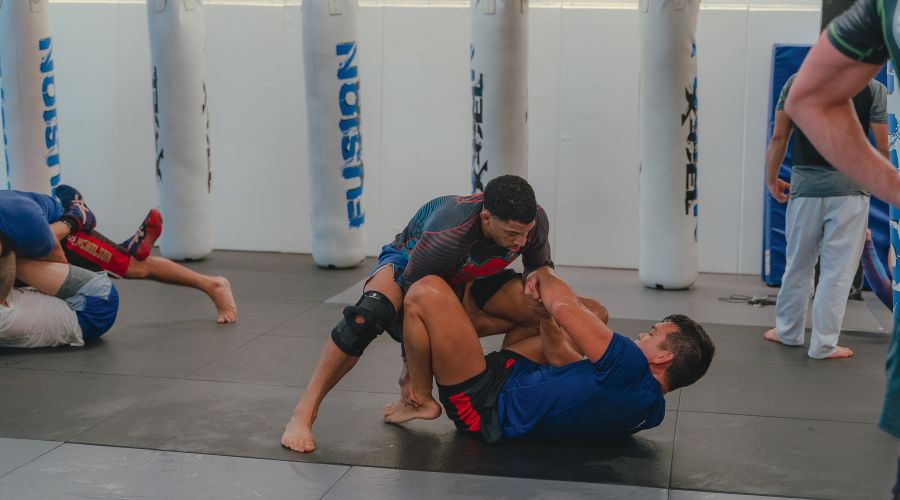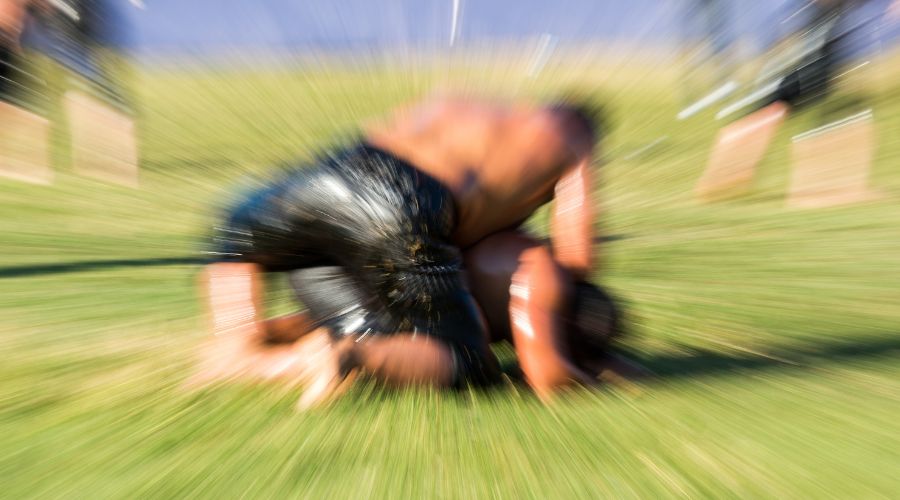It can be hard to follow all the rules and names in the grappling world for people immersed in it, let alone for casual viewers. For example, the terms submission wrestling, submission grappling, BJJ, and no-gi are thrown around for things that look the same on the surface but, in reality, aren’t. So, what’s the difference, then?
The key difference between Brazilian Jiu-Jitsu and submission wrestling is that BJJ practitioners wear a gi, which is used during grappling as a weapon and to manipulate the opponent. Submission wrestling is an umbrella term for no-gi grappling styles and competitions with slightly different rules than pure BJJ, and techniques from other styles are more commonly used.
Brazilian Jiu-Jitsu and submission wrestling have seen an enormous rise in mainstream popularity over the last few years, and knowing all the details about both can be helpful for practitioners and spectators alike.
What Is The Difference Between BJJ and Submission Wrestling
Let me start by saying submission wrestling and submission grappling are technically the same thing, worded differently.
The two are also used interchangeably with no-gi BJJ, but this is only partially correct, and we will look at why further in the article. But first, let’s go over the main differences in detail to see what separates Brazilian jiu-jitsu from submission wrestling.
Clothing
The single most crucial aspect that determines almost everything else is the clothing. Traditional BJJ is done with a gi, also called a kimono, which can be grabbed, pulled, and used as a weapon to manipulate the opponent.
This drastically changes the grappling game and is the main factor influencing the other differences between the styles.
In submission wrestling, there is no gi, and grapplers wear tight rash guards and BJJ shorts and can even be topless under some rules. The shirts and shorts cannot be grabbed or manipulated in any way. This difference is more significant than a layman may think.
Friction And Speed

The heavy cotton gi provides a lot of friction in two ways. First, the fabric-to-fabric contact creates friction but soaks up sweat. In comparison, without it, grapplers quickly become like human eels and are much harder to hold on to.
The other major way the gi slows the overall grappling speed down is by the grips it allows. You can grab every part of your or the opponent’s gi, including the lapel, sleeve, or legs. These solid grips cannot be easily broken and drastically slow the pace. Acquiring and breaking gi grips is a major element of BJJ absent in no-gi and submission wrestling.
The lack of friction and grips makes submission grappling matches usually faster and more dynamic. Static positions quickly become scrambles, with less room for a slow and methodical approach.
The gi readjustment is another method by which it slows down competition. According to IBJJF regulations, competitors are given a maximum of 20 seconds to readjust their gis, which, in more extreme cases, may amount to a couple of minutes of downtime. There are no such breaks in submission grappling.
Submissions
The gi provides many grips and more submission opportunities, namely, gi chokes. A full arsenal of chokes is only available thanks to the lapel and sleeves, like bow and arrow, baseball bat, brabo, and many others.
The gi also makes other chokes like the darce and anaconda harder to pull off because the gi gets in the way.
But an extensive element missing from gi BJJ are leg locks. Over the past few years, leg entanglements and leg submissions have completely changed how submission grappling matches are played, as they have become a core element for every high-level grappler.
In BJJ, heel hooks are banned even at the black belt level, and knee bars, ankle locks, and calf slicers are not allowed for the lower belts. Having the option to go for gi chokes and not allowing many leg attacks makes BJJ tactics quite different from no-gi and submission wrestling ones.
Athleticism
Physical attributes like strength, speed, and endurance are more critical in submission grappling than in BJJ, which is a continuation of the previous points. The more dynamic matches and lack of secure grips mean you must rely more on your athleticism than you would in the gi.
This is not to say technique doesn’t matter in no-gi or you don’t need strength in the gi, but the importance of physical attributes is much higher and more demanding in the former. This also changes the training process, creating a greater need for dedicated strength and conditioning sessions in submission grappling.
Rules And Banned Techniques
As I’ve pointed out in the submission section, BJJ, under the most popular IBJJF ruleset, has a lot of restricted techniques, even for higher-ranked belts. Submission grappling is much less restrictive, especially at the professional level, where almost all holds are allowed.
What’s more, the IBJJF ruleset is a lot stricter regarding disqualifications. Even attempting a banned technique can lead to a direct DQ, and many things can instantly cost you the win.
For example, slams are not allowed in any scenario, while under the ADCC, you can slam the opponent if you are trapped in a submission.
Under ADCC rules, no positive points are awarded during the first half of the match. For instance, in a 10-minute qualifying round match, you cannot win positive points for the first 5 minutes, and the same is true for the first 10 minutes of a 20-minute finals match. This rule promotes actively seeking submissions rather than plying only for points.
On the other hand, BJJ tournaments award advantages in resolving tiebreakers. Advantages are given when you are on the verge of completing a submission or achieving a position, but they are frequently unfair and do not exist in submission wrestling.
Is There A Difference Between No-Gi BJJ and Submission Wrestling

Many people consider no-gi BJJ and submission grappling the same, and it’s not entirely wrong. The only real thing separating the two is the different rulesets, which place more importance on certain techniques than others.
For example, under the ADCC rules, clean takedowns and sweeps score more points than those ending in guard, making them more valuable for winning matches.
In addition, directly sitting on the ground without pulling guard on the opponent (something prevalent in BJJ) is also penalized. Then the ADCC allows more techniques and submissions, including twisters, can openers, and leg locks.
But these are just ruleset details that change the game plan rather than the nature of the sport. Some people distinguish between no-gi BJJ and submission grappling because much more techniques and styles are covered under the submission wrestling moniker, like wrestling, judo, catch wrestling, and sambo.
Wrestlers have significantly impacted submission grappling because they have no competitive outlet as adults. The whole freestyle wrestling system is geared toward grade school, high school, and university students.
Wrestlers past this age found a new home in the no-gi community, and the techniques and attitudes they brought, in addition to the leg lock systems, changed traditional BJJ to such an extent that some people prefer to label it in a different category called submission grappling.
A few years ago, the difference between the two was more pronounced because the techniques and tactics used in no-gi were just modifications of the traditional gi ones.
But with more and more people adopting techniques from other styles, the lines have blurred to the point where no-gi and submission wrestling are the same.
To summarize, the only meaningful differences are between gi grappling and no-gi grappling. Everything else is minor technicalities, rulesets, and labels.
Summary
BJJ is a form of submission wrestling, but it’s not the only one. The term submission grappling was created to label a style of no-gi grappling that is still largely BJJ but with heavy influences from other styles like catch wrestling and sambo.
The key characteristic of BJJ and the factor that determines most of the other differences is the gi used as a weapon and changes the flow of wrestling due to the added grips and friction.
Submission grappling is a broader term encompassing no-gi styles and rules sets, including no-gi BJJ. The biggest brand for submission grappling is the ADCC, while the IBJJF is the largest organization for pure BJJ.
